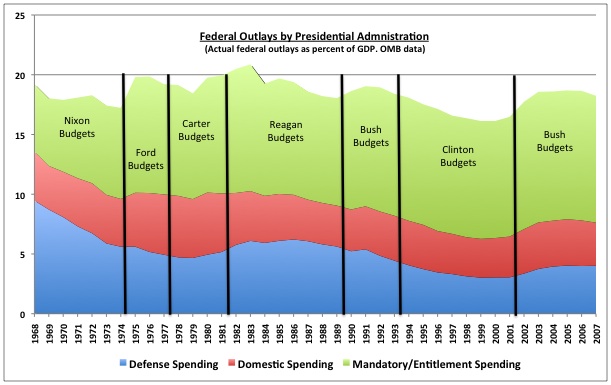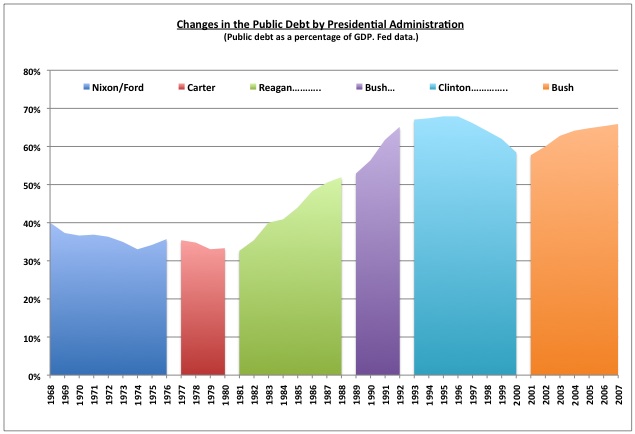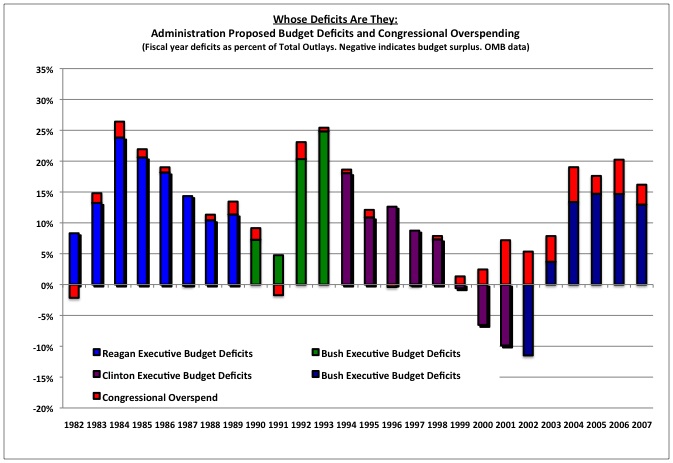
John McCain will no doubt hammer Barack Obama in the debate and the remaining days about how Democrats will spend America into oblivion. Despite the massive spending and borrowing over the past eight years, this argument still resonates. The battle for the hearts and minds of independents in the center is the lingering power of the identification of the Republican brand with fiscal conservatism.
When confronted with the devastating performance of Republicans in power over the past eight years, Republicans will do anything but look in the mirror. Whatever the cause of our fiscal mess, it is not Republican's.
It is Democrats who love to spend! It is Congress, they pass the money bills! It is old people and the AARP!
Perhaps some facts are in order.
Since the 1970s, when the Republican Party began its embrace of supply-side economics, Milton Friedman cautioned his Republican colleagues not to be disingenuous. Despite the tax-cut rhetoric that was becoming the Party's new mantra, the true size of government is measured by spending, and fiscal deficits are simply deferred tax increases. To cut taxes and keep spending is not conservative, Friedman insisted, it is simply dishonest.
As much as McCain supporters would like to cling to the notion that the Republican Party remains true to its long-abandoned principles, the historical evidence does not support their argument. The argument that Republicans are either the party committed to smaller government or to balanced budgets is purely specious.
As illustrated in the graph below, going back forty years to 1968--the starting date for data readily available from OMB and the Congressional Budget Office--through twenty-four years of Republican leadership and sixteen years of Democrat leadership, the overall size of the federal government, as measured by total outlays, has remained largely constant at 20% of the Gross Domestic Product--economic shorthand for the size of the US economy. Most notable during this period has been the growth of mandatory spending programs--primarily Social Security, Medicare and Medicaid--which have risen from 5.6% of GDP to 10.6% of GDP, and the concurrent 44% decline in discretionary spending, which largely comprises defense and domestic spending.

As this graph illustrates, the most dramatic decline in discretionary spending came under Nixon--the last Republican president elected as a traditional fiscal conservative before the Reagan Revolution--as defense spending declined significantly with the wind-down of the Vietnam War. Discretionary spending also declined significantly under Clinton--who famously pronounced that on fiscal matters "We are all Eisenhauer Republicans now"--and to a modest extent under Reagan.
Under Jimmy Carter, overall discretionary spending was flat under --defense spending rose a bit, while domestic spending fell--while discretionary spending rose as a percentage of GDP under Ford and George W. Bush.
The data shows that discretionary spending, and in particular domestic spending, fell under both Democratic presidents, while it rose under both Bush presidents. The data on the public debt is less ambiguous, as illustrated below. Here, the pattern is clear. The change in Republican Party doctrine to embrace of supply-side economics brought with it an acceptance of deficit spending and a build-up of the national debt as the price of growth--even if over the long-term the growth never brought the books back into balance.
As illustrated here, the national debt under Nixon--an old-time conservative Republican--as well as under Carter.

Fiscal deficits took off during the Reagan presidency, as the Reagan tax cuts were implemented without commensurate reductions in federal outlays. The public debt doubled as a percentage of GDP during the Reagan-Bush years
During the Clinton years, shrinking deficits and ultimately budget surpluses contributed to a decline in public debt. Finally, under George W. Bush, new tax cuts combined with war spending have contributed to renewed growth in the national debt.
Faced with the evidence that Republican presidents have left deficits and debt in their wake, supporters will insist that deficits are the fault of Congress, and particularly Congressional Democrats. But here again, the OMB data tells a different story. Executive budget recommendations and the impact of Congress on spending and deficits are tracked within OMB data beginning in 1982. The OMB data presents the executive budget recommendation, the actual deficit that was realized, and determines the extent to which the difference--generally a higher deficit--resulted from Congressional over-appropriation, economic factors or technical factors.
This graph illustrates the annual executive budget recommendation for each year, and the impact of subsequent Congressional action in red. While Congressional spending bills over-spent the executive recommendations in almost all years, the impact of this overspending was generally a fraction of the deficit starting point in the executive budget.

This data suggests that--as one would certainly hope would be the case--that the primary driver of fiscal outcomes is the recommended administration budget, despite the desire to put our fiscal mess at the feet of Congress. During the period 1982-2007, administration budget recommendations contained average deficits of 10% of outlays, while the average impact of Congressional over-spending was 1.9% of outlays. Prior to the current administration, where the impact of Congress is overstated due to the war appropriations being kept out of the executive budget and funded through supplemental appropriations, Congressional over-spending averaged just 0.8% per year.
Nor do spending patterns provide evidence to charges that the fiscal culprit is the innate profligacy of Democrats. Congressional over-spending during years when Democrats controlled both houses of Congress averaged 0.4% of outlays, and averaged 0.6% when Democrats controlled both houses of Congress and the White House. During years when Republicans controlled both houses of Congress, overspending averaged 2.3% of outlays, and 4.6% when Republicans controlled both houses of Congress and the White House.
No doubt the McCain campaign will continue to push the time-honored tax and spend attacks. But the fact is that both parties spend--though I would argue that due to their historical reputation, Democrat presidents actually are under greater pressure to control spending than their Republican counterparts--the difference is whether they pay for their spending, or borrow the money and push off the day of reckoning.
Now, however, as the day of reckoning is coming closer and our fiscal obligations are weighing heavier, the dishonesty of the Republican stance over the past quarter century--as described by Milton Friedman--should be discussed openly and honesty.
Because, all politics aside, it's time to put the country first.
